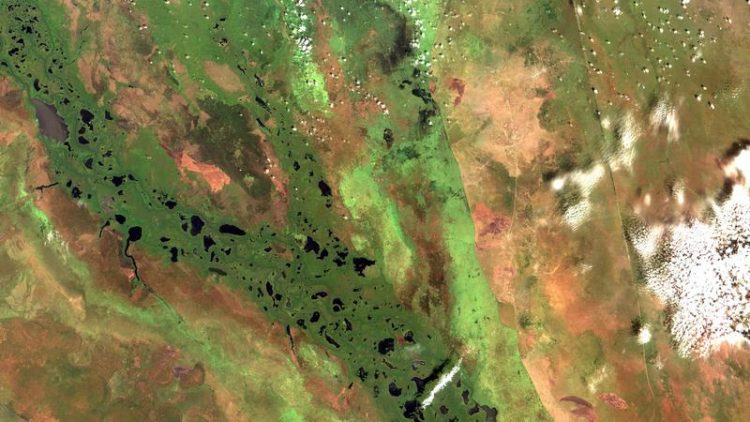One-third of recent global methane increase comes from tropical Africa

Aerial image of the Sudd wetlands in South Sudan Coordenação-Geral de Observação da Terra/INPE via Flickr CC BY SA 2.0
“One of the suggestions for the continued rise in atmospheric methane, based on ground-based data, is that tropical sources have increased,” says Mark Lunt, an atmospheric scientist at the University of Edinburgh and lead author of the study.
He and his co-authors used data retrieved from GOSAT, the Japanese Greenhouse gases Observing Satellite, to examine annual—and even seasonal—trends in Africa between the latitudes of 26° N and 26° S.
“There are very few studies that have focused in detail on Africa, primarily because there isn’t much atmospheric methane data from there,” says Lunt. “Using satellite data gives a unique perspective on the continent that wouldn’t otherwise be available.”
Previous studies that have included African methane emission estimates have utilised global models, which are run at relatively coarse resolutions and resolve emission changes at continental scales.
By instead focusing exclusively on sub-Saharan Africa, Lunt and his co-authors were able to run a regional model at a much higher resolution than would be feasible with a global version. This difference allowed the researchers to focus on changes in individual countries—a level of detail that could not previously be achieved.
The results indicate that about a third of the global atmospheric methane increase observed between 2010-2016 originates in Africa’s tropics. Most of this came from East Africa, including a pronounced, short-term boost in emissions from the Sudd, one of the world’s largest wetlands, in South Sudan.
“Our research highlights the importance of Africa, and even individual wetlands, in terms of their contributions to the global methane budget,” says Lunt. But, he says, it’s also important to note that the study period only dates back to 2010, the year GOSAT came online.
“Based on this work, we cannot say anything about what started the rise in 2007,” says Lunt. The team also cannot yet account for the source of additional increases in methane emissions they observed in East Africa. “Agriculture or other wetlands are likely suspects,” says Lunt, “but we need more evidence to prove this.”
According to Lunt, the findings could be used to improve wetland models, inform where intensive field campaigns should take place to identify the underlying causes of tropical methane emissions, and ultimately help us understand Earth’s future climate.
“In order to understand how methane might change in the future, it is essential that we can adequately explain changes in the present and recent past,” says Lunt. “Studies such as this can help narrow down the list of possible explanations, and hopefully improve our predictive capabilities for the future.”
Paul Palmer
School of GeoSciences
University of Edinburgh
+44 (0) 131 650 7724
pip@ed.ac.uk
Mark Lunt
School of GeoSciences
University of Edinburgh
mark.lunt@ed.ac.uk
Press officer
Terri Cook
European Geosciences Union
Munich, Germany
+49 89 2050 76340
https://doi.org/10.5194/acp-19-14721-2019, 2019
https://www.egu.eu/news/560/one-third-of-recent-global-methane-increase-comes-fr…
Media Contact
All latest news from the category: Earth Sciences
Earth Sciences (also referred to as Geosciences), which deals with basic issues surrounding our planet, plays a vital role in the area of energy and raw materials supply.
Earth Sciences comprises subjects such as geology, geography, geological informatics, paleontology, mineralogy, petrography, crystallography, geophysics, geodesy, glaciology, cartography, photogrammetry, meteorology and seismology, early-warning systems, earthquake research and polar research.
Newest articles

First-of-its-kind study uses remote sensing to monitor plastic debris in rivers and lakes
Remote sensing creates a cost-effective solution to monitoring plastic pollution. A first-of-its-kind study from researchers at the University of Minnesota Twin Cities shows how remote sensing can help monitor and…

Laser-based artificial neuron mimics nerve cell functions at lightning speed
With a processing speed a billion times faster than nature, chip-based laser neuron could help advance AI tasks such as pattern recognition and sequence prediction. Researchers have developed a laser-based…

Optimising the processing of plastic waste
Just one look in the yellow bin reveals a colourful jumble of different types of plastic. However, the purer and more uniform plastic waste is, the easier it is to…



